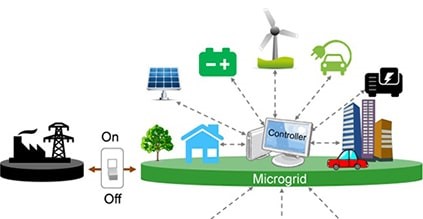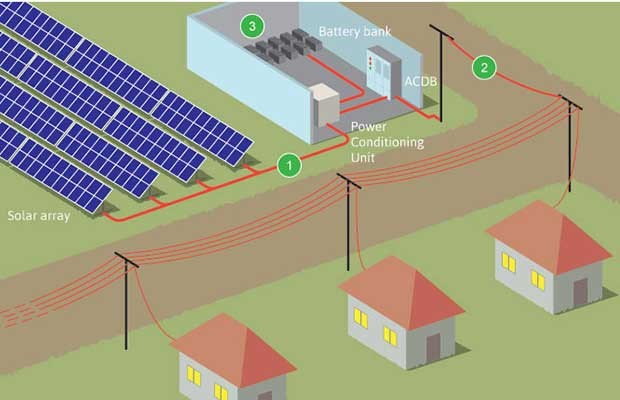Owing to their ability to provide decentralized power through various renewable energy sources (solar, wind, biogas), clean energy microgrids are increasingly being viewed as the solution for harnessing uninterrupted electricity, even in the face of extreme weather events. These weather events usually pose a challenge to electricity supply from the main electricity grid, leading to power outages, which in turn led to industrial/commercial operations coming to a standstill. Since microgrids can operate independently from the main electricity grid and are equipped with backup energy storage, they are more resilient options for electricity generation. Additionally, harnessing energy from renewable/low-carbon sources makes microgrids more sustainable and contributes towards mitigation of greenhouse gas (GHG) emissions. Through various business models such as power purchase agreements with third party operators and Pay As You Go (i.e. flexible electricity consumption and flexible payments), clean energy microgrids have the dual benefit of being economical in the long term as well as a sustainable electricity source.
Previous developments in the area of microgrid project implementation and policymaking related to microgrids were showcased in Walden’s “Microgrids-Current Events” blog in August 2020.

Development of Microgrids Market
The market for microgrids has been steadily evolving over the last two decades and continues to be polished by the Federal Energy Regulatory Commission (FERC). In September 2020, the FERC released Order 2222, which provided a pathway for distributed energy resources (DERs) to compete along with traditional power plants and other grid resources in wholesale markets. This mandate permits the integration of various technologies, such as energy storage, on-site renewables, energy efficiency, distributed and backup generators, electric vehicles and their charging equipment, and other energy systems common in microgrids. Networking of different technologies makes it possible for distributed energy systems to satisfy the minimum size and performance requirements, which may not have been feasible to be achieved individually. This opened doors for any and all microgrid systems to compete in the electricity market.
What is the “Plan for a Clean Energy Revolution and Environmental Justice” About?
The pending U.S. administration’s climate policies include a major emphasis on the development and implementation of microgrid projects. This forms the crux of the “Plan for a Clean Energy Revolution and Environmental Justice” program. A key aspect of this program is the declaration to invest $1.7 trillion in clean energy, climate research and innovation over the next decade.
Other features of this program include:
- Incentives for accelerated implementation of clean energy technologies across the economy, with a focus on communities affected by climate change
- Investment in clean energy resilience by federal facilities
- Integration of environmental justice to energy planning
The holistic and community-oriented nature of this program comes forth through the proposal to engage environmental justice communities in energy planning, with a goal to ensure that these communities receive maximum benefit through the development and implementation of clean energy technologies. An environmental justice community refers to a community with significant representation of communities of color, low-income communities, or tribal and indigenous communities that face or are at the risk of facing higher or more disadvantageous human health or environmental effects.

What other steps were taken with respect to Microgrids Infrastructure?
The “Plan for Clean Energy Revolution and Environmental Justice” is the next step to the “Moving Forward Act”. In June 2020, the “Moving Forward Act” was introduced in a bid to ensure that clean energy investment is a substantial part of any economic recovery package, and implementation of microgrids is an integral part of this act. As part of the act, a $1.5 trillion infrastructure plan to improve renewable energy grid modernization, resilience measures and microgrids was proposed. Primary features of the act include:
- Extension of federal investment tax credit for solar and geothermal energy
- Increase of incentive for solar and geothermal energy back up to 30% through 2025 before phasing out over a few years
- Expansion of tax credit to include standalone energy storage systems and extend tax incentives for carbon capture and storage technologies for a few more years
Another recently introduced legislation that augments the investment towards microgrids infrastructure is the “Energy Resilient Communities Act”, which aims to provide $1.5 billion in grants for clean energy microgrids. Some of the aspects for which the funds allocated for the Clean Energy Microgrid Grant Program can be used as part of the “Energy Resilient Communities Act” include the following:
- Technical assistance for development of infrastructure resilience plans to identify and overcome known climate change hazards to critical community infrastructure
- Conduct a needs assessment of prospective clean energy microgrid projects and, as applicable, design prospective clean energy microgrids, including assistance to address permitting and location challenges, understand and aid financing options, and understand the technical characteristics of clean energy microgrids
- Provide community outreach and collaborative planning with respect to clean energy microgrid projects
- Carry out a project to develop and install a clean energy microgrid that supports critical community infrastructure or a clean energy microgrid for residences of medical baseline communities
Are you wondering if microgrids fit the bill for your facility or community? Consult with the environmental engineers of Walden. Walden Environmental Engineering can provide a wide range of services for microgrid projects, ranging from meeting regulatory requirements, performing energy audits and calculations to designing customized plans that will be the best fit for you. Call Walden to discuss your project needs at 516-624-7200.
